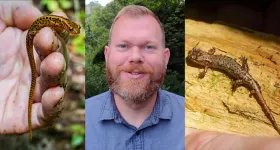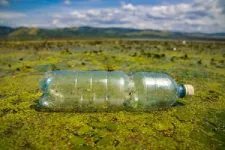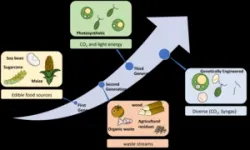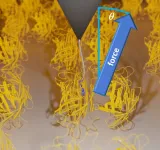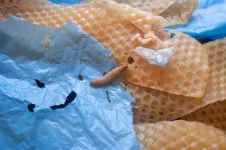(Press-News.org) URBANA, Ill. – For tiny salamanders squirming skin-to-soil, big-picture weather patterns may seem as far away as outer space. But for decades, scientists have mostly relied on free-air temperature data at large spatial scales to predict future salamander distributions under climate change. The outlook was dire for the mini ecosystem engineers, suggesting near elimination of habitat in crucial areas.
Now, University of Illinois researchers are tuning into the microclimates that really matter to the imperiled amphibians and forecasting a somewhat more hopeful future.
“The older estimates were predicting almost 100% of the suitable habitat being wiped out for some of these species. But once we incorporated microclimate data at fine spatial scales for our study area in Great Smoky Mountains National Park (GSMNP), we found it might not be nearly that severe.
“It’s still bad, though; our estimates showed 55-80% reduction in habitat for the three species we studied, but that’s a big difference when we’re talking about a large area,” says study co-author Sam Stickley, assistant professor in the Department of Natural Resources and Environmental Sciences (NRES), part of the College of Agricultural, Consumer and Environmental Sciences at U of I. Jennifer Fraterrigo, also an NRES professor, co-authored the study.
Surprisingly, and for the first time, the team was also able to locate potential gains in highly suitable habitat area for three GSMNP plethodontid salamander species under future climate scenarios. Lacking lungs, plethodontids “breathe” entirely through their skin. They’re currently quite abundant in GSMNP, Stickley says, but when their overall range begins to shrink in the future, the predicted areas of gain could be prioritized for conservation or park management.
But let’s step back for a moment. Ecologists model species distribution based on what they know about the critter’s environmental requirements and where on the landscape those requirements may be met. The results are displayed like a heat map overlaid on real landscape features, with color gradients indicating low to high habitat suitability. It’s usually an exercise done at large spatial scales: GIS maps showing soil and vegetation types on a kilometer scale or larger, along with climate models developed from regional weather stations.
But salamanders and other small animals don’t operate on those scales. They’re right up next to – or in – the soil, oftentimes carrying out their entire lives within a few square meters. At or near the forest floor, temperature and moisture are much more stable than in open areas, where weather stations tend to be located.
“Using free-air temperature data doesn’t account for the buffering effect of forests,” Stickley says. “The forest is pushing solar energy back out, absorbing it, altering wind patterns, and there are plant-water interactions; just all sorts of microclimate variables near the surface that aren’t accounted for in typical climate layers.”
With the advance of small digital environmental sensors, it’s now easier to gather microclimate data at biologically relevant scales for ground-dwelling animals – for example, 3 square meters vs. multiple kilometers – but species distribution modeling using data at fine spatial scales is still relatively rare.
Stickley obtained a colleague’s data from hundreds of mountaintop locations where the three salamander species, along with many others, make their homes (GSMNP isn’t called the “Salamander Capital of the World” for nothing). He then ran distribution models for each species using standard data inputs (free-air temperatures) or microclimate data from the park, producing distribution maps for three time periods: 2006-2010, 2030, and 2050.
Again, the free-air models predicted much greater habitat loss by mid-century than the microclimate models for all three species. And they underestimated many areas the microclimate models predicted would become highly suitable habitat: a total of 3 square kilometers (km2) for the Ocoee salamander, 9 km2 for the pygmy salamander, and a whopping 39 km2 for the red-cheeked salamander.
“The red-cheeked salamander is endemic to the Smoky Mountains, only found in a small range of high-elevation areas in Great Smoky Mountains National Park and a few little areas nearby,” Stickley says. “To find a relatively large area of potential gain in highly suitable habitat could be important information for park managers and conservationists.”
Stickley is optimistic that fine-resolution, microclimate-based species distribution models will become more common with increased data availability and better modeling techniques. In this case, they offer a glimmer of hope for the Salamander Capital of the World, but even microclimate-based models aren’t perfect. They can’t account for disease, predation, or other biotic interactions snipping the threads of the web of life. But, to Stickley, they’re a worthy exercise if their outcome leads to conservation efforts to protect his favorite amphibians.
“Salamanders are a really integral part of the forest food web. They're eating all these insects and shredding and decomposing that stuff into the soil. They're also cycling nutrients across the forest, within the streams, and all the way up to the highest elevations,” he says. “People don’t realize how many salamanders are under their feet in a forest, performing all these key ecosystem functions. They collectively outweigh the biomass of every other vertebrate in the GSMNP, so the role they play in this ecosystem is extremely important to preserve.”
The study, “Microclimate species distribution models estimate lower levels of climate-related habitat loss for salamanders,” is published in the Journal for Nature Conservation [DOI: 10.1016/j.jnc.2023.126333]. The research was supported by a grant from the National Science Foundation (award #1339944).
END
Hope for salamanders? Illinois study recalibrates climate change effects
2023-03-31
ELSE PRESS RELEASES FROM THIS DATE:
Engineered E. coli delivers therapeutic nanobodies to the gut
2023-03-31
BOSTON-- Humans are colonized with thousands of bacterial strains. Researchers are now focused on genetically modifying such bacteria to enhance their intrinsic therapeutic properties.
One goal is to develop smart microbes that release therapeutic payloads at sites of disease, thus maintaining therapeutic efficacy while limiting many of the side effects that can be associated with the systemic administration of conventional drugs.
Investigators at Massachusetts General Hospital (MGH), a founding member of Mass General Brigham (MGB), have engineered a strain of the probiotic Escherichia ...
New type of friction discovered in ligand-protein systems
2023-03-31
An interdisciplinary research team of the Institutes of Physical Chemistry and Physics of the University of Freiburg and the Max Planck Institute of Biophysics in Frankfurt-am-Main has discovered a new, direction-dependent friction in proteins called anisotropic friction. “Until now, nobody had observed that friction in biomolecules was dependent on direction,” says physicist Dr. Steffen Wolf of the University of Freiburg. The results have been published as cover story in the scientific journal “Nano Letters.”
Experiments on model complex of protein-ligands
Proteins constitute the microscopic machinery of cells. They perform work during their functional cycles. Accordingly, ...
New UNC Chapel Hill study quantifies $562M in financial risk from Hurricane Florence using novel modeling approach that evaluates risk of mortgage default and property abandonment
2023-03-31
When Hurricane Florence made landfall on North Carolina’s coast in 2018, it brought record rainfall causing catastrophic flooding and damages to communities across the eastern portion of the state.
Estimating the financial impacts of household flooding is complex because direct damages often snowball into other financial risks, like a decrease in property value or loss of equity. Generally, post-disaster damage assessments focus on insured and uninsured losses, but these numbers do not account for the secondary impacts to households, lenders, local governments and other stakeholders who may also share in the financial consequences if a property owner defaults ...
What is foreign exchange market or simply Forex?
2023-03-31
The Forex market, also known as the foreign exchange market or simply Forex (short for "foreign exchange"), is a decentralized global market where various currencies are traded. It is the largest financial market in the world, with a daily trading volume exceeding $6 trillion. The primary purpose of the Forex market is to facilitate international trade and investment by allowing businesses, governments, and individuals to convert one currency into another.
Can cities make room for woodpeckers?
2023-03-31
Researchers are deploying the latest mapping techniques to identify the most important suburban habitat for North America’s largest woodpecker.
University of Cincinnati doctoral student Ruijia Hu said wildlife habitat in congested places like southwest Ohio is becoming increasingly fragmented as forests give way to new construction. Eventually, this could spell trouble to an animal with specific habitat needs like Ohio’s pileated woodpecker.
Pileated woodpeckers are crow-sized birds with colorful red crests and striking white facial stripes. They are found in forests from British Columbia to Florida. They have the ...
Study: ChatGPT has potential to help cirrhosis, liver cancer patients
2023-03-31
A new study by Cedars-Sinai investigators describes how ChatGPT, an artificial intelligence (AI) chatbot, may help improve health outcomes for patients with cirrhosis and liver cancer by providing easy-to-understand information about basic knowledge, lifestyle and treatments for these conditions.
The findings, published in the peer-reviewed journal Clinical and Molecular Hepatology, highlights the AI system’s potential to play a role in clinical practice.
“Patients with cirrhosis and/or liver cancer and their caregivers often have unmet needs and insufficient knowledge about managing and preventing complications of their disease,” ...
A healthy microbiome may prevent deadly infections in critically ill people
2023-03-31
Twenty to 50 per cent of all critically ill patients contract potentially deadly infections during their stay in the intensive care unit or in hospital after being in the ICU – markedly increasing the risk of death.
“Despite the use of antibiotics, hospital-acquired infections are a major clinical problem that persists to be a huge issue for which we don’t have good solutions,” says Dr. Braedon McDonald, MD, PhD, an intensive care physician at the Foothills Medical Centre (FMC) and assistant professor at the ...
Academic institutions receive lower financial returns from biotechnology licenses than commercial firms
2023-03-31
BENTLEY UNIVERSITY
The financial terms of biotechnology licenses from academic institutions are significantly less favorable than those of comparable licenses between commercial firms according to a new study from Bentley University’s Center for Integration of Science and Industry. The study, published in the journal PLOS ONE, shows that the royalties and payments to academic institutions are significantly lower than those to commercial firms for similar licenses and products at the same stages of development.
The article, titled “Comparing the economic terms of biotechnology licenses from academic institutions with those ...
Harnessing nature to promote planetary sustainability
2023-03-31
As Earth’s population grows, the demands of modern lifestyles place mounting strain on the global environment. Proposed solutions to preserve and promote planetary sustainability can sometimes prove more harmful than helpful. However, technologies that harness natural processes could be more successful.
Such technologies are the focus of the latest issue of the open access journal PLOS Biology, which features a special collection publishing March 31st of papers highlighting biology-based solutions that could be applied to reduce carbon dioxide emissions, eliminate non-degradable plastics, produce food or energy ...
Study examines how social rank affects response to stress
2023-03-31
Can an individual’s social status have an impact on their level of stress? Researchers at Tulane University put that question to the test and believe that social rank, particularly in females, does indeed affect the stress response.
In a study published in Current Biology, Tulane psychology professor Jonathan Fadok, PhD, and postdoctoral researcher Lydia Smith-Osborne looked at two forms of psychosocial stress — social isolation and social instability — and how they manifest themselves based on social rank.
They conducted their research on adult female mice, putting them in pairs and allowing them to form a stable ...
